Most architects and designers know their work speaks volumes. But presenting it in a way that truly persuades clients or employers is a challenge.
And that’s because an architecture portfolio isn’t just a collection of images, it’s your calling card, your story, and your proof of expertise. Do it well, and you can spark curiosity, build trust, and land more jobs.
In this guide, you’ll see exactly what to include in an architecture portfolio, how to organize it, and expert tips that transform your portfolio from a simple showcase into a powerful business tool.
Key Takeaways
- An architecture portfolio is a curated tool that demonstrates your skills and builds trust with clients.
- It should include formatted project pages, visuals, and personal details tailored to your audience.
- The most effective portfolios use storytelling, consistent visuals, and smart organization.
- Architects can use Cedreo to create professional 2D/3D floor plans, photorealistic renderings, and polished presentations for their portfolios.
Why trust us? Here at Cedreo, we’ve got 20+ years of experience working with professionals in the home design space. We know what it takes for architects and designers to create visual presentations that lead to more jobs!
See How You Can Create Complete Projects with Cedreo
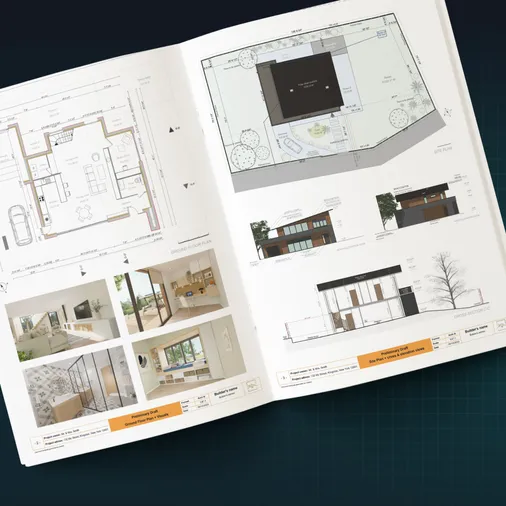
Plans – Get site plans, 2D floor plans, electrical plans, cross sections and elevation views — with all the technical details you need for a comprehensive project overview.
3D Visualizations – Use interior and exterior 3D renderings as well as 3D floor plans to help clients understand the finished project.
Documentation – Manage all your visual documents in one place, so it’s easier to present and sell your projects.
No credit card required, no commitment
What is an Architecture Portfolio?
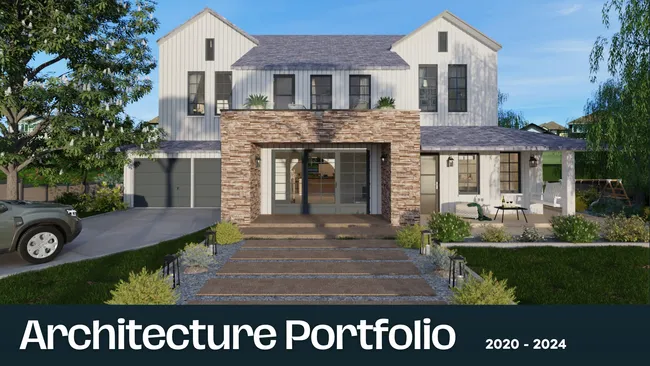
An architecture portfolio is a carefully curated collection of your best architectural design work. It highlights your creativity, technical ability, and professionalism while telling the story of your architecture career.
Unlike a school project, a professional portfolio is a powerful marketing and sales tool. It reassures potential clients or employers that you have the skills to handle their project.
Whether you’re a student preparing for interviews or a seasoned designer showcasing projects, your portfolio is the proof of your practice, creativity, and design process.
Why an Architecture Portfolio is Essential
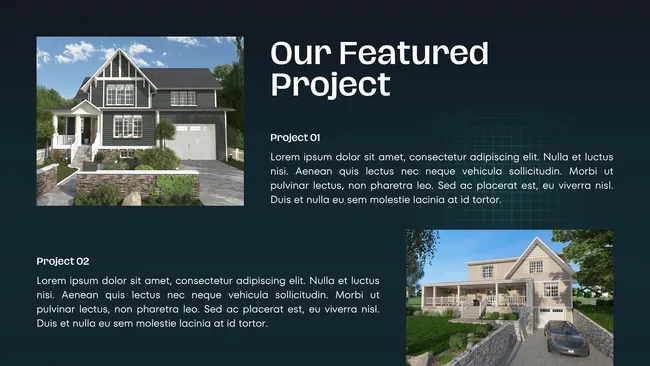
An architecture portfolio isn’t just a collection of work. It’s proof of your skill and design thinking and it can make the difference between winning a client or getting overlooked.
Build Trust with Clients
Your portfolio reassures clients that you are a skilled professional. Seeing past work builds credibility and demonstrates you can deliver what you promise.
To build trust, go beyond polished images. Include clear project details, design process notes, and even client testimonials when possible. The more transparent you are about your role and results, the more trust you build with prospective clients or employers.
Demonstrate Design Capabilities
Showcasing a range of project types (residential, commercial, remodels, and new builds) demonstrates that you can adapt to different client needs and contexts. Show more of your process and skills by including:
- Architectural design sketches
- Hand drawings
- Technical documents that reveal your problem-solving process
Highlight the client’s needs and wants by including details from discovery meetings. Then show floor plans and renderings to illustrate how you meet your client’s needs and can present design concepts clearly.
Showcase Completed Projects
Nothing builds confidence like proof of real-world results. Include:
- Completed project photography
- Before-and-after comparisons
- Client feedback
Pair renderings with post-project photos to create a compelling story arc that bridges vision and reality, and showcases your ability to deliver.
Convince and Inspire
A great portfolio can spark imagination and help clients picture themselves in the finished space.
- High-quality renderings provide persuasive visuals that build confidence and make decision-making easier. Pair those renderings with before-and-after images or post-project photography to show the transformation more vividly.
- Highlight how your concepts became tangible results, so clients clearly see what it’s like to work with you.
- Adding short narratives about client goals and outcomes ties everything together and positions you as a design partner who inspires and delivers.
Common Challenges and How to Overcome Them
Every architect faces obstacles when putting together a portfolio. This section highlights the most common roadblocks and gives you practical ways to overcome them.
No Previous Projects
The Challenge: If you’re just starting out, you may not have real client projects to show, which can make your portfolio look sparse.
How to Overcome It: Showcase conceptual designs, class projects, or competition entries. Use professional-quality visuals to ensure your portfolio looks polished, even without real-world client work.
Limited Project Variety
The Challenge: If most of your work is in one area, your portfolio may not reflect the full range of your skills.
How to Overcome It: Diversify by designing hypothetical projects. Show different building types and styles to highlight your adaptability.
Low-Quality Photos or Drawings
The Challenge: Poor image quality can make even great projects look unprofessional.
How to Overcome It: Use high-resolution images, professional formatting, and plenty of white space. It’s better to use fewer high-quality images than to clutter the portfolio with too many low-quality images.
PRO TIP! Use a professional 3D design program like Cedreo. It helps architects like you quickly generate polished renderings, create hypothetical projects to fill gaps, and produce professional-quality visuals that overcome these common challenges.
Who is the Target Audience for Your Portfolio?
Before you design your portfolio, ask: who will view it? Then adapt it to your target audience.
- Residential clients: They want to see how you design comfortable, livable family homes. Highlight spaces like kitchens, living rooms, and outdoor areas where lifestyle and function meet.
- Commercial clients: They focus on functionality, efficiency, and scale. Show how you’ve solved design challenges for offices, retail, or mixed-use projects and include drawings that demonstrate practicality and flow.
- Potential employers: They’re evaluating your design process, not just outcomes. Showcase sketches, project stages, and your ability to collaborate, so they can see how you think and work.
- New builds: Prospective clients planning new construction want to see how you approach projects from the ground up. Demonstrating your ability to create functional layouts, technical drawings, and renderings for fresh designs can set you apart.
- Renovations: Clients focused on remodeling want to know how you transform existing spaces. Highlight before-and-after comparisons and design solutions that adapt old structures to modern needs.
Once you understand what your target audience needs to see from your portfolio, tailor your project pages and storytelling to each audience so they immediately see the value you bring.
What to Include in an Architecture Portfolio
Here are the must-have elements that give your portfolio structure, clarity, and professional polish.
Standard Portfolio Formatting
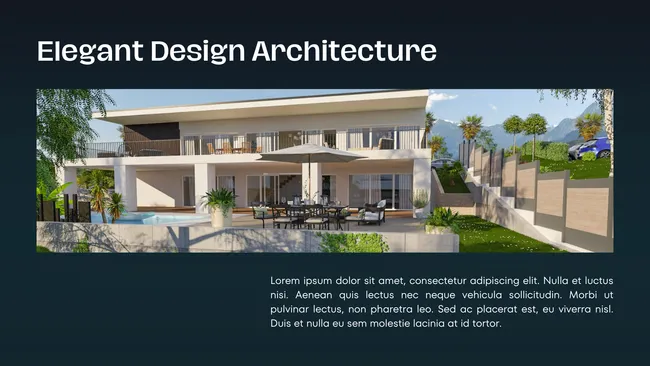
Here’s a sample format you can follow when organizing your pages, adapted from professional best practices. Adapt the length and detail of each section depending on whether you need to prepare a sample portfolio (for quick reviews) or a full portfolio (for detailed evaluations).
- Cover page: Include your name, logo, and contact details.
- Resume or CV section: 1-2 pages highlighting education, certifications, and professional experience.
- Table of contents: Especially useful for portfolios over 15 pages.
- Introduction page: Briefly state your design philosophy or approach.
- Project pages: Normally 2–6 pages per project depending on the project size. Organize them either chronologically or by project type. Each should include a title page, short description, and supporting visuals that showcase the design process.
- Supporting visuals: High-quality sketches, technical drawings, renderings, and photos. Use captions to explain context.
- Professional bio & contact information: A concise closing page with personal details and clear next steps.
Keep the file size small enough to email, and use consistent fonts with strategic white space.
Visual Elements
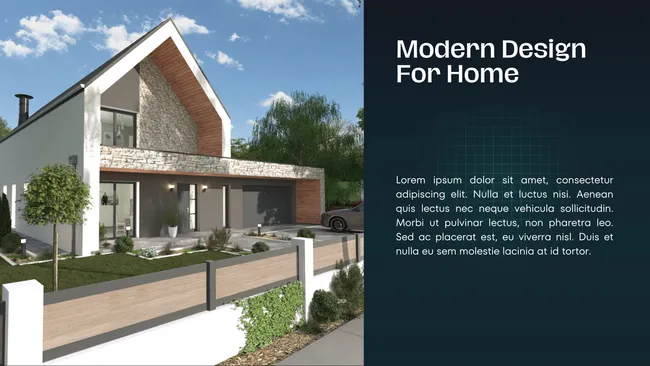
Strong visuals make your portfolio stand out, but each type of visual adds something unique to your story:
- Technical drawings show your accuracy, attention to detail, and ability to translate ideas into buildable plans.
- Post-project photography proves your concepts became real-world results, helping clients trust your ability to deliver.
- Cross-sections and elevations highlight how spaces function and flow, not just how they look from the outside.
- Exterior renderings illustrate the curb appeal and how a design integrates with its surroundings.
- Interior renderings showcase atmosphere, finishes, and how furnishings interact with space.
- Site plans provide context and demonstrate technical competency.
Professional Bio, CV & Contact Information
A professional bio and CV can appear at the beginning of your portfolio, or you may prefer to place them at the end on the last page. What many architects do is start with their CV and design philosophy up front to set the stage, and then use the final page to list their name, contact information, and clear next steps. Some provide a condensed bio at the beginning and a full CV on the last page or two.
Here are some expert tips for making your bio and CV stand out in your portfolio:
- Lead with a value statement: Instead of just listing job titles, describe what you bring to a project or client relationship.
- Show your design philosophy in action: Pair it with a quick example or project reference that illustrates how you apply your approach.
- Highlight outcomes, not just responsibilities: Mention measurable results, awards, or recognition that prove your impact.
- Tailor your language to your audience: Use terms that resonate with potential employers, clients, or collaborators.
- Keep it personal but professional: Add a touch of personality like a passion, interest, or influence that helps readers remember you.
Best Practices for an Eye-Catching Architectural Portfolio
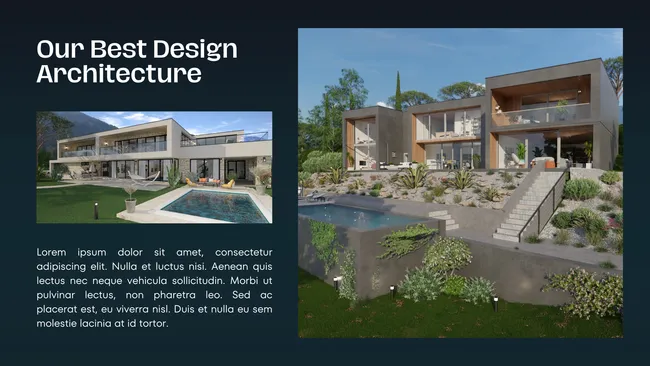
These proven strategies will help you refine your portfolio so it looks polished, professional, and compelling to any audience.
Tell a Story
Use a narrative that highlights challenges, solutions, and results. Storytelling makes your portfolio more memorable and persuasive. To strengthen your narrative:
- Frame each project like a mini case study.
- Use short, clear captions under images to guide the reader.
- Include client goals and how your design addressed them.
- End each story with measurable results or a lesson learned.
Maintain Visual Consistency
Consistency reinforces professionalism and helps your portfolio feel intentional from start to finish. To achieve this:
- Keep fonts, colors, and formatting uniform across every page.
- Use consistent spacing, margins, and image styles so your portfolio feels cohesive.
- Limit your palette to 2–3 fonts and 2–3 colors to avoid distractions.
- Carry through subtle branding elements like logos, line weights, or graphic motifs.
- Ensure project titles and captions follow the same structure so readers can navigate easily.
Optimize for Sharing
Make sure your portfolio is easy to share in both digital and print formats. To maximize accessibility:
- Create a compressed PDF version for email submissions.
- Host an online portfolio on your website for quick access.
- Prepare a printed version for interviews or in-person meetings.
- Ensure images and text display clearly across devices and screen sizes.
- With Cedreo, you can export projects in multiple formats ready for online or offline sharing.
Quality Over Quantity
A few strong, detailed projects are more effective than many weaker ones. Always choose clarity and impact over volume. To make this principle work in your portfolio:
- Limit yourself to 4–6 of your very best projects rather than cramming in everything you’ve ever done.
- Curate projects that show range (different building types, scales, and styles) so fewer examples still demonstrate diversity.
- Edit ruthlessly. Remove anything with weak visuals or incomplete details.
- Make each project page rich with process, visuals, and outcomes, so even one project can stand on its own.
- Consider rotating projects for different audiences instead of trying to show everything at once.
How to Make an Architecture Portfolio Step-by-Step
This section walks you through the process of building your portfolio step by step so you can move from a rough collection of work to a polished, professional document.
Step 1 – Decide How to Structure and Organize Your Information
Start with formatting and layout decisions. Plan the flow, choose page order, and ensure your portfolio tells a clear story.
Ask yourself:
- Should readers see your most recent project first, or your strongest?
- Would a chronological order make sense, or is grouping by project type more compelling?
At this stage, sketch a rough outline of how many pages you’ll dedicate to each project. This early planning sets the tone for the rest of your portfolio.
Step 2 – Select Your Best Work

Choose projects that showcase diverse styles and project types. Highlight the work that best represents your skills and creativity.
Tips for selection:
- Balance large-scale projects with smaller, detail-focused ones.
- Include both technical and creative projects to show range.
- If you lack real-world projects, use conceptual work or academic examples.
Step 3 – Structure Your Layout
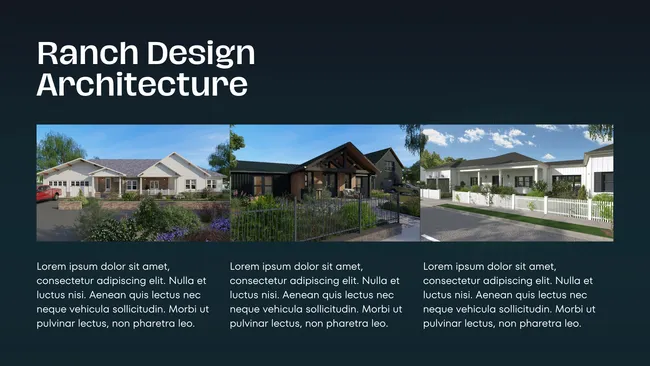
Organize each project using a story-driven format: challenges, solutions, and results. Keep layout clean, with proper title pages, page numbers, and white space.
For improved readability:
- Use consistent formatting so readers know what to expect.
- Add callouts or captions to highlight key design decisions.
- Include section dividers if your portfolio is longer to make it easy to navigate.
Step 4 – Use the Right Tools
Skip outdated design programs, as they often limit your ability to create modern, high-quality visuals and can slow down your workflow.
With Cedreo, you can create 2D and 3D floor plans and assemble professional presentation documents quickly so it’s easy to ensure your portfolio looks current and polished.
Step 5 – Refine and Edit
Remove weaker projects, tighten layouts, and double-check formatting. A polished, concise portfolio makes a stronger impression.
When it’s time to refine it:
- Ask a colleague or mentor to review it. Fresh eyes often catch inconsistencies.
- Revisit your portfolio regularly. As you complete new projects, update and refine.
- Keep only the most relevant, impressive projects so your portfolio grows with your career and always feels current.
Architecture Portfolio Examples
For inspiration, here are some real-world portfolios. As you examine these, ask yourself:
- How do they use storytelling?
- How do they guide you through each project?
- What visuals are included, and how are they combined?
- How do they format and structure the portfolio?
- How do they allow their personality to show?
This analysis will help you pull valuable insights you can apply directly to your own portfolio.
Portfolio examples:
- Olena Hordynska: Architecture Portfolio selected works 2022-2024
- Eren Kavci: Architecture Portfolio
- Rajat Verma: Architecture Portfolio
- Philip Goolkasian: Academic and Professional Architectural Design Work, 2014-2018
How to Share Your Online Portfolio and Get New Leads

Now that you’ve built your portfolio, don’t let it sit idle. Share it strategically across different channels to maximize visibility and impact:
- Social Media: Instagram, Pinterest, and LinkedIn are ideal platforms for design visuals. Share both finished projects and behind-the-scenes design process content to show depth and build engagement.
- Portfolio Sites: Many architects highlight their work with publishing sites like Issuu or Behance.
- Networking: Present your work at local events, collaborate with builders and remodelers, and bring a printed or tablet-ready version to client meetings.
- Local SEO: Optimize your online portfolio or personal portfolio website so local clients can find you. Include relevant keywords, update your project pages regularly, and make sure your site is mobile-friendly.
- Email marketing: Send curated project highlights to past clients or prospects with a link to your online portfolio.
- Professional organizations: Submit your portfolio or projects to local architecture boards, competitions, or industry showcases.
Create Your Standout Architecture Portfolio Today
A strong architecture portfolio is your most powerful marketing tool. It builds trust, showcases creativity, and proves your ability to deliver results.
Here’s how Cedreo can elevate your portfolio:
- 2D/3D floor plans that communicate design intent clearly.
- Photorealistic renderings that inspire clients and make projects feel real.
- Professional presentation documents that keep your portfolio polished and consistent.
- Time-saving design tools that let you create and refine visuals faster.
Ready to create high-quality portfolio visuals that win clients? Try Cedreo free today.
Architecture Portfolio FAQs
It’s a curated collection of design work that demonstrates your skills and process. More than just pretty images, it tells the story of how you think, design, and solve problems. For an architecture student, it reflects how you’ve developed ideas through class projects, school work, or university programs. A strong portfolio shows both visuals and explanations so readers (clients, employers, or fellow architects) understand what you created and how you approached it.
Quality matters more than quantity. Include 4–6 projects that show a range of skills and styles. Each should have visuals and a short narrative about challenges and results. Students or early-career professionals can include academic work, such as a school project that shows how one image developed into a layout with furniture and details.
It’s essential. A portfolio often decides whether you land clients or employers. It shows results, process, and professionalism. In many cases, it’s the first impression that opens doors to interviews, jobs, or projects. Expect it to be as critical as your resume, since a portfolio shows how you think visually and strategically.
Use a mix: hand sketches to show creativity, technical drawings for precision, renderings to help people visualize, and post-project photos to prove results. Adding site plans, layouts, or graphic design elements can enrich the story. Mixing different visuals gives a fuller picture of your skills.
Keep it concise. 20 to 50 pages is typical. Two to six pages per project usually works well. Watch file size so it’s easy to email. The last page should include your name, contact details, and a clear call to action. Aim for a portfolio that can be reviewed in 10–15 minutes while still showing your skills and personality.



